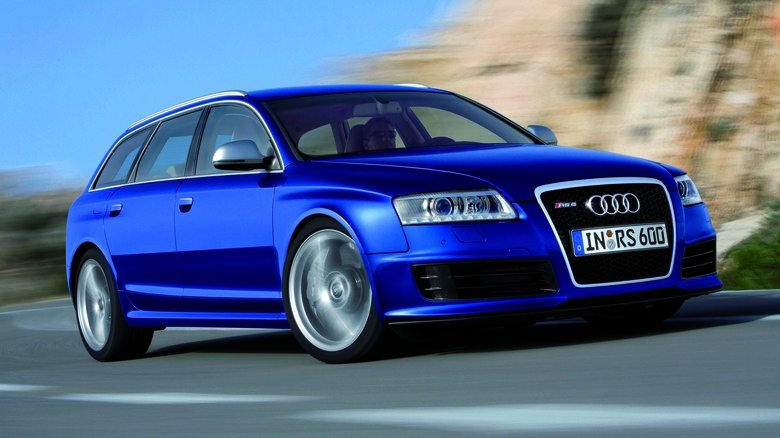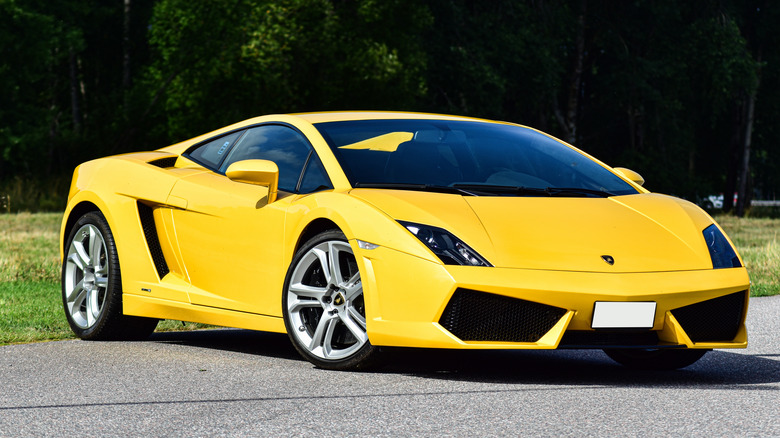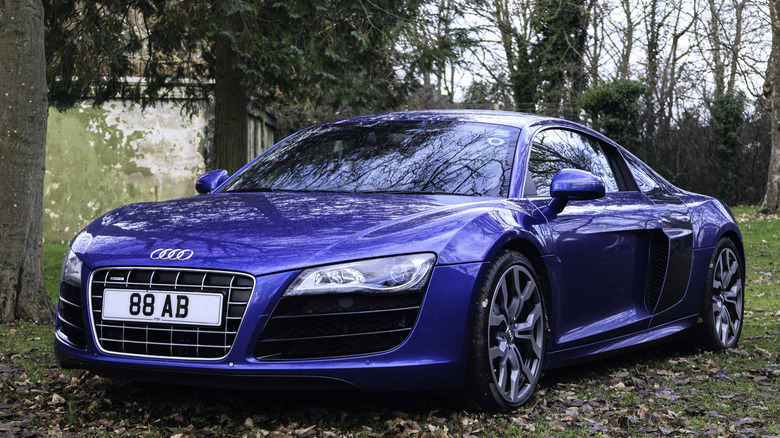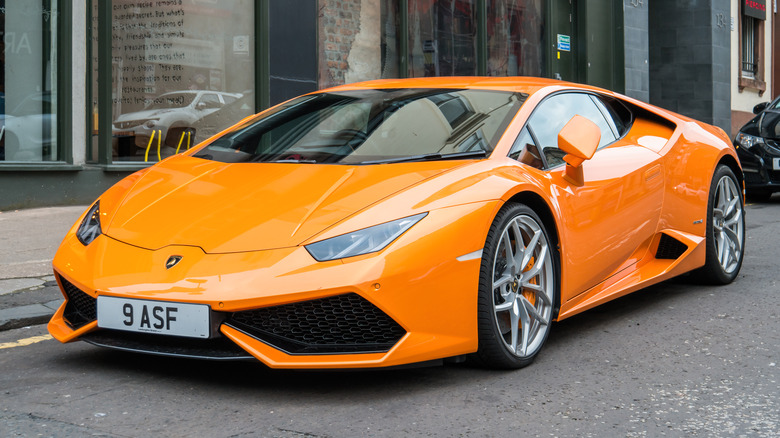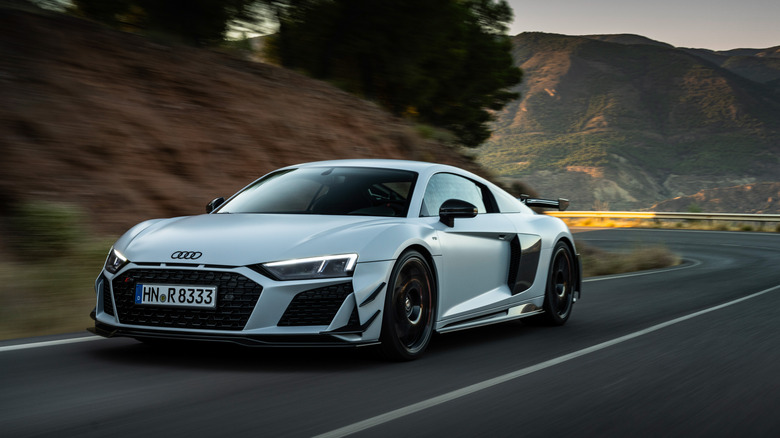These Are The Best Cars Ever To Use A V10 Engine
We're approaching a pretty sad time for the car industry. As both the Lamborghini Huracan and the Audi R8 have reached the end of the line, they're taking the seminal V10 engine along with them. Audi is still unsure what the future of the R8 holds, while the Huracan's successor is already confirmed to use a hybrid V8 powertrain.
The V10 engine is one of the auto industry's biggest curiosities, but it's also a fine powertrain type. Over the past 30 years, it hasn't done much for that many cars, as it was only reserved for properly special cases. Automakers that did decide to use a V10 engine made sure of one thing: car enthusiasts certainly wouldn't forget these absolute beasts. From the car that started the V10 performance car craze, all the way to the twilight years, the auto industry has given us some true gems with 10 cylinders arranged in a V.
The Kickoff: Dodge Viper
In the late 1980s, Dodge put together a skunkworks team that got to work on a rather insane project: creating a modern interpretation of the all-conquering AC Cobra. A big engine under the hood, RWD, and not much else. The end result also carried a very appropriate name: Viper.
Although it wasn't certain that the Viper would reach production, overwhelming interest greenlit the project. One look at the original Viper makes one thing abundantly clear: this will never happen again.
Nestled under the massive hood of the first Viper was an equally massive 8.0-liter V10 engine putting out 400 horsepower. That was a huge number for that time, and it was especially a lot for a car that wasn't especially massive, and also had zilch in terms of safety features. Not even windows. With the Viper drumming up significant interest, and with the V10 coming to define it, other automakers decided to explore this layout for their own performance cars.
The Italian Take: Lamborghini Gallardo
Throughout most of the 20th century, Lamborghini's focus was almost entirely on their V12 flagships. Unfortunately, its numerous attempts at an entry-level model, like the Urraco and the Jalpa, were almost always destined for failure. After the Audi acquisition in the late 90s, Lambo decided to do the whole entry-level supercar thing properly, and this time, it actually stuck.
The Gallardo was introduced in 2003 – totally different from the other baby Lambos that came before. Instead of a tiny displacement V8 and RWD, the Gallardo switched over to a 5.0-liter V10, engineered in-house, and it came standard with AWD.
Thanks to Audi's input, the Gallardo was also a lot more grounded in reality, and not a total nuisance to live with on a daily basis, which couldn't be said about many Lambos that came before. The most notable thing about the Gallardo's V10 was its even firing order, which gave it a unique and instantly recognizable sound. Most of the time when there's a supercar on-screen in a major action flick, this is where the sound comes from.
The Final Analog Supercar: Porsche Carrera GT
It was only supposed to be a concept car, but Porsche eventually decided to turn the Carrera GT concept into the ultimate supercar expression in just about every conceivable way. It wouldn't be kind to call the Carrera GT the German Viper, even though both cars used a V10 engine and didn't use any electronic assistance systems. That's where the commonalities between the two begin and end.
Porsche wanted the Carrera GT to be all about the driver. There was no stability control, there was no quick-shifting automatic transmission, the Carrera GT's only assistance system was the driver's skill level. With a notoriously difficult clutch and struggles for grip, the Carrera GT was pure analog supercar bliss — for better, and for worse.
That's not even touching on the Carrera GT's powertrain. Porsche designed the 612 horsepower 5.7-liter V10 for racing purposes, but not only did they end up sticking it in a road car, they also managed to extract even more power from it than the concept car. That sort of thing simply doesn't happen anymore. In addition to being an excellent performer, the Carrera GT's V10 puts out a truly thrilling sound.
A V10 For The Whole Family?: Audi RS6 Avant (C6)
As we all know, the '00s were the final decade when automakers could truly go crazy with powertrains in their vehicles, and the Germans took this matter more seriously than just about anyone else. Not wanting to be outdone by BMW sticking a V10 under the hood of the M5, Audi decided to do the very same thing with the RS6 Avant of the era. To one-up BMW, however, Audi gave it two turbochargers.
While not as crazy visceral as the M5 in terms of sound, the RS6 Avant made up for that in another very important area: firepower. The twin-turbo V10 put out a massive 579 horsepower, which didn't just wipe the floor with the competition, but it's also not too far off from the current RS6. In the mid 2000s, this kind of power from a station wagon was something to gasp at.
AWD came as standard, of course, and the power reached the wheels through a conventional six-speed torque converter automatic. Still, that didn't stop the C6 RS6 from reaching 60 mph in the mid-four-second range, an unheard of figure for a family wagon at the time. Not to mention, the C6 RS6 is definitely an embodiment of a factory sleeper.
A New Lease of Life for The Baby Lambo: Lamborghini Gallardo LP560-4
After the original Lamborghini Gallardo ran for a few years, competition was heating up, and Lamborghini decided it was high time for an update. Befuddling naming strategy aside, the Gallardo LP560-4 received some major improvements in 2008. In addition to updated styling and interior appointments, there was a new V10 below the glass on the rear.
The original Gallardo's 5.0-liter V10 put out a plentiful 500 horsepower, but that wasn't quite enough for Lambo. The updated car received a new 5.2-liter V10 with 552 horsepower (560 metric horsepower), hence the name. Despite the added power and improved performance, the 5.2 sadly lost the even firing order of the original, leading to a more conventional odd-firing V10 sound.
Still, that didn't mean there was any less drama. The Gallardo was still composed when it needed to be, but even with the new V10, the Gallardo could put on quite a show, not just for the ears but for all the other senses as well.
The Benefits of Partnership: Audi R8 V10
Back in 2006, Audi blessed the world with one of its most important cars of the past 20 years: the R8. Designed as an aspirational halo car for the brand, the R8 was the first proper supercar to come out of Ingolstadt, helped in no small part by the relationship with Lamborghini. A relationship that would strengthen only a couple of years into the original R8's life.
Initially, the R8 debuted with a 4.2-liter naturally-aspirated V8, very similar to what you might have found in the B7 RS4. By 2009, Audi nudged the R8 into supercar territory with the 5.2 FSI V10.
As the name implies, a 5.2-liter V10 replaced the V8. Two extra cylinders and 1000cc more also meant a significant increase in power to 518 horsepower, allowing the R8 to grace 200 mph for the first time. When paired with the gated manual transmission, the V10 R8 was a stunning car to drive. The V10 became so important to the R8, that by the time the second generation came around, it was the sole powertrain option.
With Love from Japan: Lexus LFA
To this day, the Lexus LFA is not an icon just because of how impressive it is, but also because it had one of the most gut-wrenching stories of any supercar. Lexus wanted to make a supercar for a very long time, but it simply couldn't agree on what the car should be made of, how it should be engineered, or what it should look like.
Eventually, everything was settled by the late 2000s, when the LFA finally made its official debut. Toyota, with the help of skilled Yamaha engineers, put together a 4.8-liter V10, that also managed to have the same measurements as a V8 and weigh about the same as a V6. It may have had only 552 horsepower, but it took only 0.6 seconds to opera solo its way to 9,000 rpm. To this day, enthusiasts often cite the LFA as one of, if not the best-sounding car of all time, and that is completely justified.
The Next Generation Of V10 Bull: Lamborghini Huracan
After a 10-year production run and over 14,000 units sold, Lamborghini finally closed the Gallardo chapter in 2013, in preparation for the successor. The Huracan was introduced in 2014, along with a much sharper and more modern styling. It used a much improved version of the 5.2-liter V10.
This time, power went up significantly to over 600 horsepower, dropping the Huracan's 0-60 time in the low three-second range. It can also rev to 8,500 rpm, for good measure. AWD was still standard, though Lambo did some further experiments with the RWD Huracan, offering it as a more regular part of the lineup. Also notably, the Huracan was the first Lamborghini model to use a dual-clutch transmission, ditching the Aventador's ISR.
The V10 also introduced dry sump lubrication, and Lamborghini did not hold back on power in future iterations of the Huracan, with both the Evo and the Performante sailing past 630 horsepower. Combined with the incredible aerodynamics and electronics, more recent iterations of the Huracan can drop the 0-60 time well below three seconds.
The Ultimate Audi V10: R8 GT
What a way for the Audi R8 to bow out, after a successful production run spanning well over 15 years. Borrowing its name from another super limited version of the first-generation car, the latest R8 GT is the ultimate expression of Ingolstadt's lessons learned along the way, and it's a truly spectacular closing chapter in the German-Italian supercar's life.
Even though the R8 GT is being released at a very different time from when the R8 first appeared, it still hasn't given up its signature trait, the V10. Boasting 602 horsepower, the 5.2-liter V10 is still just as raucous and as much of a special experience as it's always been, but in the GT, the driver must be alert at all times: it's RWD only.
That makes it the most powerful RWD R8 ever, and it also means that concentration will definitely be required when behind the wheel. As the V10 screams way past 8,000 rpm on a long straightaway, it's a bittersweet feeling, as this is the last time we'll ever see anything with an Audi badge and a V10.
The Ultimate Lambo V10 Trio: Sterrato, STO, and Tecnica
Just like the R8, the Huracan is also knocking on the door of retirement. Instead of one special edition to send it off, Lamborghini is offering its customers three very different takes on the well-established and well-loved Huracan formula. The Tecnica is the ultimate road-going Huracan, borrowing some chops from the track versions but being usable on a daily basis.
The STO, meanwhile, is the absolute all-out track special, offering incredible aerodynamics and a personalization program that can lead to some truly hideous but also fantastic exterior color combinations. While you could use the STO on the road, it's not a great idea.
Finally, there's the Sterrato, Sant'Agata Bolognese's answer to the Porsche 911 Dakar. The Sterrato represents everything we love about the Huracan in a package that doesn't cry when it sees the gravel on the racetrack. Instead, the Sterrato can drive over a racetrack made of gravel. Naturally, all three of these use the iconic 5.2-liter V10, putting out 631 horsepower in the STO and Tecnica, and 602 horsepower in the Sterrato.
As Lamborghini has already revealed the surprisingly rev-happy hybrid V8 that the Huracan's successor will use, it's time to wave goodbye to one of the finest and most unique engine types the auto industry has ever seen.
So long, V10.




